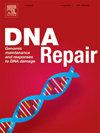无蛋白聚核糖(adp -核糖)的PARP酶合成:对DNA损伤信号传导和修复的意义
IF 2.7
3区 生物学
Q2 GENETICS & HEREDITY
引用次数: 0
摘要
聚(adp -核糖)或PAR是一种多功能信号分子,对人类生物学有着广泛的影响。PAR是细胞DNA损伤和基因组交易(如复制和转录)的重要指标。通常,人类的PARP酶会在蛋白质上产生PARP修饰物。最近,人们发现PARP酶可以产生不附着在蛋白质上的自由PAR分子。游离PAR与细胞死亡信号有关,但游离PAR的产生被认为是通过糖水解酶将蛋白质连接的PAR分解成更小的片段而产生的。在DNA损伤反应中,PARP1直接从头产生游离PAR,同时合成蛋白连接的PAR,这表明游离PAR在DNA损伤信号传导中起着更普遍的作用。本文综述了在生物化学反应和DNA损伤反应的细胞模型中游离PAR合成的发现。这一发现的意义在DNA损伤信号和生物分子凝聚形成的相关过程以及Parthanatos细胞死亡信号的背景下进行了总结。本文章由计算机程序翻译,如有差异,请以英文原文为准。
PARP enzyme synthesis of protein-free poly(ADP-ribose): Implications for DNA damage signaling and repair
Poly(ADP-ribose) or PAR is a versatile signaling molecule with a broad impact on human biology. PAR is a prominent indicator of cellular DNA damage and genomic transactions such as replication and transcription. Canonically, human PARP enzymes create PAR as a modification on proteins. Recently, PARP enzymes were found to create free PAR molecules that are not attached to protein. Free PAR has been implicated in cell death signaling, but the production of free PAR was assumed to be generated by glycohydrolases breaking down protein-linked PAR into smaller fragments. The direct de novo production of free PAR by PARP1 occurs alongside the synthesis of protein-linked PAR in response to DNA damage, suggesting a more prevalent role for free PAR in DNA damage signaling. This review outlines the discovery of free PAR synthesis in biochemical reactions and in cellular models of the DNA damage response. The implications for this finding are summarized in the context of DNA damage signaling and associated processes of biomolecular condensate formation and Parthanatos cell death signaling.
求助全文
通过发布文献求助,成功后即可免费获取论文全文。
去求助
来源期刊

DNA Repair
生物-毒理学
CiteScore
7.60
自引率
5.30%
发文量
91
审稿时长
59 days
期刊介绍:
DNA Repair provides a forum for the comprehensive coverage of DNA repair and cellular responses to DNA damage. The journal publishes original observations on genetic, cellular, biochemical, structural and molecular aspects of DNA repair, mutagenesis, cell cycle regulation, apoptosis and other biological responses in cells exposed to genomic insult, as well as their relationship to human disease.
DNA Repair publishes full-length research articles, brief reports on research, and reviews. The journal welcomes articles describing databases, methods and new technologies supporting research on DNA repair and responses to DNA damage. Letters to the Editor, hot topics and classics in DNA repair, historical reflections, book reviews and meeting reports also will be considered for publication.
 求助内容:
求助内容: 应助结果提醒方式:
应助结果提醒方式:


